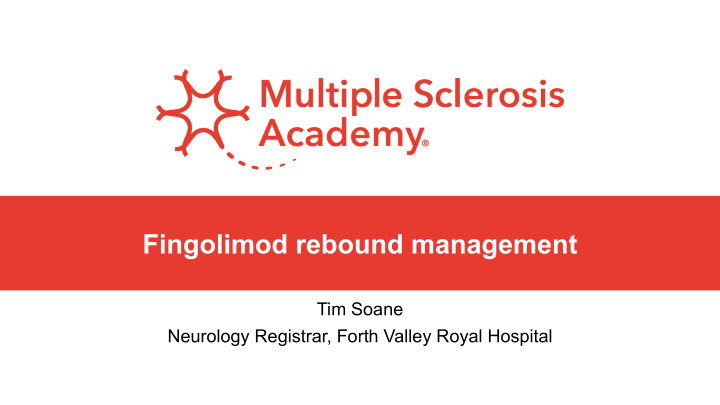



Fingolimod rebound management Tim Soane Neurology Registrar, Forth Valley Royal Hospital
Background • 45 year old right handed lady • Physiotherapist • PMHx Migraines, Depression • Allergic to sulphonamides • Lived with husband and 2 children at diagnosis
Diagnosis & Initial Management • Diagnosed RRMS 2006 one month after initial symptoms • Was started on Rebif same year • EDSS 0 but increased to 2 over next 2 years (no details)
Escalation • 2009. Prolonged relapse with right sided hemiparesis • Started on Natalizumab
Relapse soon after starting Natalizumab • 2010. A couple of months after starting Natalizumab developed left leg weakness
PML derisking • 2011. – EDSS 6.0 – JCV positive • 2012. – Switched to Fingolimod due to PML concerns, and increasing arthralgias related to infusions
More relapses • 2012, 2013, 2014 all brought further symptomatic relapses affecting vision (brainstem), gait and left arm
Alemtuzumab • 2015 decided to switch to Alemtuzumab • Approved in 2016 • 10 week washout • JCV negative CSF • Within 6 weeks of stopping Fingolimod was admitted to hospital with leg weakness and incontinence
Evolving high activity • Admitted to hospital September 2016 • Mixture of evolving CNS inflammation and infections including UTIs and pneumonia over the following months • Received in total 3xIVMP and 2xIVIg • Admitted to ICU November with bulbar dysfunction
MRI Activity
Treatment options • Initially planned to start Alemtuzumab as in patient, but had continuing active infections • Restart Fingolimod, but wasn’t working before • Switch to Natalizumab, but JCV 2.63, family not keen on PML risk, and patient never tolerated very well, and still had relapses • In the end due to ongoing infection given fingolimod via NGT in ICU
Prolonged hospital admission • Discharged to rehab, but not home until December 2017 (15 months after admission) • Zimmer frame with supervision • Blind in one eye • Spastic legs requiring baclofen • RUL ataxia but good LUL • Cognitive problems
Since discharge • Slowly improving cognition, but some concerns about capacity – and declined formal assessment • Husband died suddenly • 15 year old son now under care of friends who have guardianship • Carers and parents help out but difficult
Current problems • MRI remains active on fingolimod • Fingolimod withdrawal previously caused significant rebound • High risk of PML • Cognition and capacity • EDSS 6.0
Options • Continue with fingolimod • Switch to induction agent – Alemtuzumab • Escalate – Natalizumab – Ocrelizumab – Cladribine • HSCT • When to give / how to switch
Thank you • Special thanks to: – Christian Neumann – Katy Murray – David Hunt
Recommend
More recommend